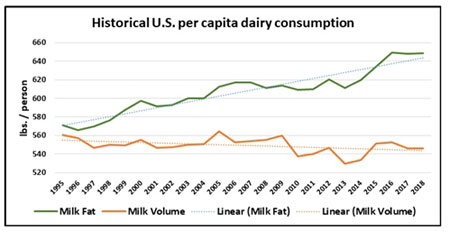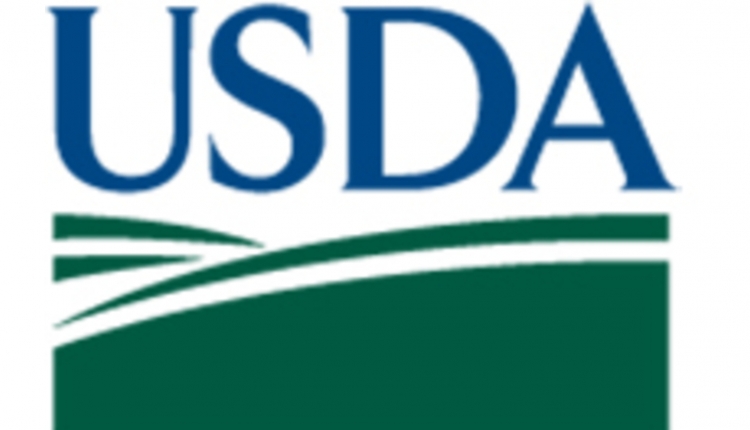
Optimizing milkfat is advantageous for both the performance of the animal and the profitability of the farm. In current dairy economics, butterfat continues to account for more than half of the producer’s milk check. With the on-going trade wars and the trade tariffs in place, the dairy export market continues to lag compared to the historic highs of recent years. In the short term, dairy producers should watch the markets to determine how to make their commodity as valuable as possible. Currently, the most profitable strategy is to maximize milkfat production without reducing volume.
When evaluating the domestic U.S. consumption of milkfat and fluid milk (as shown in the graph below), milk-equivalent milk fat basis consumption continues to rise year-after-year while general fluid milk consumption continues to trend lower. While the milk volume demand is met in the United States, Class III milk prices at the farm level will likely remain stagnant, with limited growth until export markets improve. The demand for milkfat continues to grow due to population growth and increased consumption of dairy products which include higher levels of milkfat, such as cheese and ice cream. This increased demand for milkfat should drive prices up and translate to increased profitability for dairy producers, who can enhance milkfat while maintaining production.

As we transition from summer to fall, and from hotter to cooler weather, now is the time to re-evaluate feeding strategies and to set goals for increased milkfat production. Generally, producers recognize that there is a seasonal pattern to milk components, with the summer lows somewhere in the vicinity of 0.25 percentage units below the highs commonly observed in January. It is important for producers to identify their current position in that cycle and to talk with their nutritionist about ways to improve.
Optimal milkfat production is dependent on balancing the nutrients in the rumen to promote the production of de novo fatty acids (short-chain fatty acids) while supplying fats in the ration that lead to the formation of preformed or long-chain fatty acids. A rumen environment that keeps wide fluctuations in rumen pH to a minimum through balanced carbohydrate nutrition favors the formation of acetate and butyrate, which are the precursors to de novo fatty acids.
Nutritional factors to consider for optimizing milkfat:
Limit unsaturated fat: High levels of oleic acid (C18:1) and linoleic acid (C18:2) can reduce milkfat if rumen microbes cannot biohydrogenate these fatty acids in the rumen. Many feedstuffs contain C18:1 and C18:2 in moderate to high levels, and high levels of C18:2 are the most concerning. Feedstuffs which have higher levels of unsaturated fat are distillers grains, hominy feed, whole soybeans, roasted soybeans, extruded/expelled soybeans, bakery byproducts, candy byproducts, and corn syrup byproducts. When unsaturated fats enter the rumen, the rumen bacteria try to convert them to saturated fatty acids (C18:0). This normal pathway of fatty acid conversion has no negative effects and results in normal milkfat production. The second or altered pathway is common when the rumen is overloaded with high levels of unsaturated fat. This pathway produces intermediate fatty acid compounds that have a very dramatic and negative effect on milk fat production after they escape the rumen and are absorbed in the gut. Therefore, minimizing the inclusion of feedstuffs with high levels of C18:2 can help optimize milkfat production.
Maximize diet fermentability: Evaluate your ration for adequate neutral detergent fiber (NDF) and physically-effective NDF (peNDF) as the basis for a healthy rumen and normal milkfat production. The peNDF of the ration can be evaluated using the Penn State Particle Separator. If the forage particles are too fine, acidosis can be induced as the passage rate through the animal is increased. In comparison, forage particles that are too long will lead to sorting which can also induce acidosis, due to the ration not being consumed in the appropriate ratio. In addition to fiber, the percentage of fermentable starch in the diet should also be measured and monitored in order to maintain a healthy rumen pH. Keeping the rumen healthy is the first step to a healthier milk check. Maintaining a healthy rumen environment by providing adequate amounts of fiber with the correct particle size, coupled with the appropriate levels of fermentable starch, will create an optimal situation for milkfat production.
Supplement saturated fats: There are several saturated fat products available on the market that can be supplemented based on the goals of the producer, whether those goals include increased milk production, maintained/increased body condition, and/or increased milkfat production. Palm fat (C16:0) is most commonly supplemented at a rate of 0.5 - 0.75 pounds per cow, per day to achieve increases in milk fat production. Supplemental rumen-protected palm fat delivers an instantly available fat source to the cow that can immediately be used within the animal for milkfat production.
Utilize rumen modifiers: Several feed additives have been proven to improve milkfat, based on the various indicators within a herd:
- Dietary cation-anion difference (DCAD) levels: increasing the dietary potassium with high potassium forages and/or potassium carbonate (not potassium chloride) can lead to optimized milk fat synthesis.
- Rumen buffers: supplementing sodium bicarbonate or sesquicarbonate can greatly minimize rumen pH drops, creating an optimal rumen environment for milkfat production.
- Yeast and Direct Fed Microbials: These products are supplemented to help stabilize the rumen pH and to minimize the effects of periodic ruminal challenges from wild yeast, moldy feeds, and variations to the ration.
- Methionine hydroxy analog: supplementation of these products has been shown to increase butterfat, especially in high-producing cows on high-starch diets and/or lower forage rations that tend to depress milk fat. This increase in milk fat is likely due to stabilizing the rumen environment and/or altering the rumen microbial population.
It is important to note that butterfat will vary based on stage of lactation, breed, and genetics along with variations in feeding time and meal patterns, which can result in slug feeding. Cow management such as high stocking densities that impact resting time can also result in lower butterfat. For more information or advice on how to increase your pounds of milkfat shipped, contact your local Hubbard Dealer or Hubbard Dairy Team Member.


